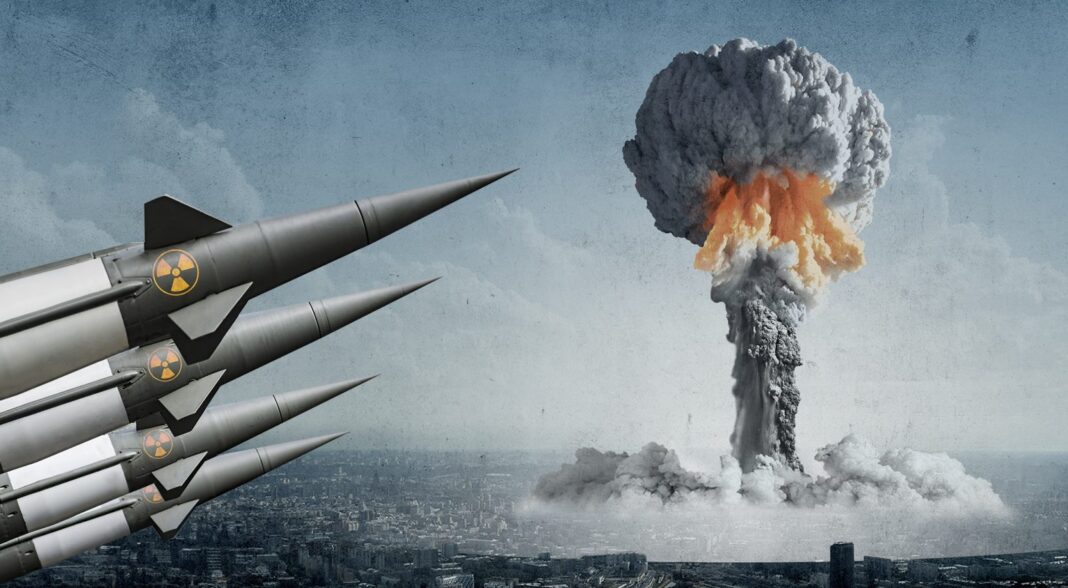By Dr. Olamide SAMUEL
Vienna.Austria(London Post) – For nearly eight decades, nuclear weapons have shaped global security, embodying a paradox: instruments of annihilation too horrific to use yet too strategically vital to discard. The debate between nuclear abolishment, which seeks the complete elimination of nuclear arsenals, and nuclear deterrence, which relies on the threat of retaliation to prevent conflict, remains deeply polarized. This tension pits moral imperatives against geopolitical realities, raising a critical question: can a middle ground reconcile these opposing visions? By exploring historical context, recent examples like Russia-Ukraine and India-Pakistan, and potential pathways forward, this article evaluates whether a balanced approach can mitigate risks while preserving stability. With approximately 12,500 nuclear warheads held by nine nations, the stakes are immense (Global Zero, 2023). |GERMAN|JAPANESE|TUEKISH|HINDI|
Historical Context
Nuclear weapons emerged during World War II through the United States’ Manhattan Project, culminating in the 1945 bombings of Hiroshima and Nagasaki, which killed an estimated 150,000–246,000 people (Atomic Heritage Foundation, 2023). These events, the only wartime uses of nuclear weapons, revealed their catastrophic potential. The Cold War (1947–1991) saw an arms race between the United States and the Soviet Union, amassing over 130,000 warheads by the 1980s (Rhodes, 1986). The doctrine of Mutually Assured Destruction (MAD) underpinned deterrence, ensuring neither side would initiate a nuclear attack due to the certainty of devastating retaliation.
The 1962 Cuban Missile Crisis brought the world to the brink of nuclear war, exposing deterrence’s fragility but proving diplomacy’s potential to avert catastrophe (National Security Archive). Key treaties followed: the 1963 Limited Test Ban Treaty, the 1968 Nuclear Non-Proliferation Treaty (NPT), and the 1987 Intermediate-Range Nuclear Forces (INF) Treaty limited testing, proliferation, and specific weapons. However, the INF Treaty’s collapse in 2019 and the looming expiration of New START in 2026 highlight ongoing arms control challenges (UN Disarmament Affairs). Nuclear-Weapon-Free Zones (NWFZs) in regions like Latin America and Central Asia show progress, but North Korea’s arsenal, Iran’s ambitions, and recent tensions underscore the precarious nuclear order.
The Case for Nuclear Abolishment
Abolitionists argue that nuclear weapons pose an existential threat. Modern thermonuclear warheads, like the Tsar Bomba’s 50-megaton yield, dwarf the 1945 bombs. A single warhead could devastate a city; a regional exchange could trigger a “nuclear winter,” collapsing agriculture and killing millions through starvation (Carnegie Endowment, 2019). The International Campaign to Abolish Nuclear Weapons (ICAN), awarded the 2017 Nobel Peace Prize, cites risks like accidental launches, referencing Cold War false alarms and “launch-on-warning” vulnerabilities (ICAN).
The 2017 Treaty on the Prohibition of Nuclear Weapons (TPNW), ratified by 93 states, declares nuclear weapons illegal, though nuclear-armed states have not joined (United Nations, 2023). Former U.S. officials like Henry Kissinger argue deterrence is less effective against non-state actors like terrorists, who are undeterred by retaliation (Kissinger et al., 2007). The spread of nuclear technology to unstable regimes heightens misuse risks. The International Court of Justice’s 1996 opinion noted that nuclear weapon use is “scarcely reconcilable” with humanitarian law, reinforcing ethical arguments. Continued reliance on nuclear arsenals diverts resources from challenges like poverty and climate change, perpetuating fear and mistrust.
The Case for Nuclear Deterrence
Deterrence advocates argue that nuclear weapons have prevented major wars for over 75 years. The Cold War’s bipolar structure, reinforced by MAD, ensured the U.S. and Soviet Union avoided direct conflict (Sagan & Waltz, 1995). Kenneth Waltz asserts that nuclear weapons create a “nuclear peace” by making war’s costs prohibitive. NATO’s 1949 Strategic Concept emphasizes deterrence as essential for collective defense, maintaining a nuclear alliance as long as nuclear weapons exist (NATO, 2025). Extended deterrence, where the U.S. provides a nuclear umbrella for allies like Japan and South Korea, has curbed proliferation.
Recent examples underscore deterrence’s role. Russia’s 2022 invasion of Ukraine, which gave up its Soviet-era nuclear arsenal in 1994 under the Budapest Memorandum, highlights the risks of disarmament without security guarantees. Russia’s nuclear saber-rattling, including threats to deploy tactical nuclear weapons, reinforces deterrence’s perceived necessity (Bulletin of the Atomic Scientists, 2024). Similarly, India and Pakistan’s nuclear standoff, particularly during the 2019 Pulwama crisis, where both nations conducted airstrikes but avoided escalation, demonstrates deterrence’s stabilizing effect in regional rivalries (Carnegie Endowment, 2019).
Critics of abolishment warn that eliminating nuclear weapons could increase conventional wars, as seen in pre-nuclear conflicts like World War I and II. Emerging technologies, like hypersonic missiles, complicate deterrence but underscore the need for credible second-strike capabilities (Global Zero, 2023).
Exploring a Middle Ground
The divide between abolishment and deterrence suggests a middle ground is challenging but feasible through stabilized nuclear competition, where states acknowledge mutual vulnerability and negotiate risk-reduction measures while maintaining limited deterrence (Carnegie Endowment, 2025). The NPT and New START demonstrate arms control’s potential. Extending New START beyond 2026 and including China and India could rebuild trust. A Fissile Material Cut-off Treaty (FMCT) could halt new nuclear material production, shrinking stockpiles without immediate abolition.
Reducing reliance on nuclear weapons is another strategy. The U.S. and Russia, holding over 90% of global warheads, could cut deployed arsenals to 500–1,000 each (Union of Concerned Scientists, 2023). No-First-Use (NFU) policies, adopted by China and India, could eliminate preemptive strike fears, though NATO resists due to conventional threats. De-alerting warheads could prevent accidental launches; over 900 remain on high alert, a risk mitigated by 1990s U.S.-Russian efforts. Expanding NWFZs and risk-reduction mechanisms, like the U.S.-Russia deconfliction hotline used in Syria, could stabilize tensions.
Recent examples highlight both challenges and opportunities. Russia’s 2023 suspension of New START inspections strained arms control, yet backchannel talks prevented escalation during Ukraine-related tensions (United Nations, 2023). India and Pakistan’s 2021 ceasefire agreement along the Line of Control shows that confidence-building measures can reduce nuclear risks even in volatile regions. However, distrust, technological advancements, and verification challenges—where a single hidden warhead could confer strategic advantage—persist.
Conclusion
The nuclear debate reflects a clash between idealism and pragmatism. Abolitionists emphasize catastrophic risks and moral imperatives, while deterrence advocates highlight stability, as seen in Russia-Ukraine and India-Pakistan dynamics. A middle ground lies in marginalizing nuclear weapons through incremental steps: reviving trilateral U.S.-Russia-China arms talks, enforcing NPT reduction timelines, and addressing emerging threats like cyber warfare. As General Omar Bradley warned in 1948, “We have achieved brilliance without wisdom, power without conscience” (Bradley, 1948). Nuclear weapons cannot be uninvented, but their dominance can be diminished through cooperation and transparency. The path to a nuclear-free world is long, but pragmatic measures can bridge the gap, ensuring humanity chooses wisdom over fatalism.
Note:This article is produced to you by London Post, in collaboration with INPS Japan and Soka Gakkai International, in consultative status with UN ECOSOC.
INPS Japan




